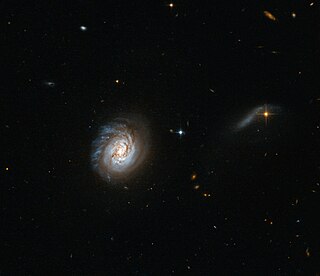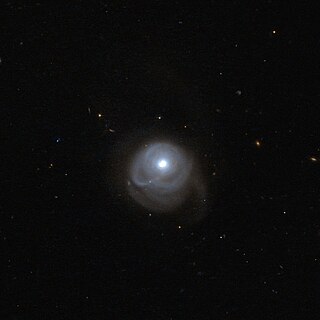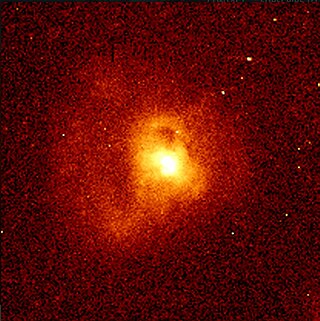
NGC 6240, also known as the Starfish Galaxy, is a nearby ultraluminous infrared galaxy (ULIRG) in the constellation Ophiuchus. It was discovered by French astronomer Édouard Stephan on 12 July 1871.
Luminous infrared galaxies or LIRGs are galaxies with luminosities, the measurement of brightness, above 1011 L☉. They are also referred to as submillimeter galaxies (SMGs) through their normal method of detection. LIRGs are more abundant than starburst galaxies, Seyfert galaxies and quasi-stellar objects at comparable luminosity. Infrared galaxies emit more energy in the infrared than at all other wavelengths combined. A LIRG's luminosity is 100 billion times that of the Sun.

APM 08279+5255 is a very distant, broad absorption line quasar located in the constellation Lynx. It is magnified and split into multiple images by the gravitational lensing effect of a foreground galaxy through which its light passes. It appears to be a giant elliptical galaxy with a supermassive black hole and associated accretion disk. It possesses large regions of hot dust and molecular gas, as well as regions with starburst activity.

FSC15307+3253 is an ultraluminous infrared galaxy (ULIRG), with a luminosity between 8 and 1000 μm of approximately 2×1013L⊙, possibly the highest currently known. The "FSC" refers to Faint Source Catalogue, one of the source catalogs produced by the IRAS infrared survey mission. The emission is believed due to some combination of starburst activity and accretion onto a super-massive black hole, producing primary radiation at shorter wavelengths which is mostly blocked by obscuring dust, which is in turn heated and re-radiates in the infrared. The redshift of the source is z = 0.93, indicating a distance of the order of 7 billion light years.

Markarian 1034 is a pair of spiral galaxies comprising PGC 9074 and PGC 9071, located in the constellation Triangulum. They are located at a distance of 465 million light-years from Earth and are classified as luminous infrared galaxies.

NGC 3256 is a peculiar galaxy formed from the collision of two separate galaxies in the constellation of Vela. NGC 3256 is located about 100 million light-years away and belongs to the Hydra–Centaurus Supercluster complex. NGC 3256 provides a nearby template for studying the properties of young star clusters in tidal tails. The system hides a double nucleus and a tangle of dust lanes in the central region. The telltale signs of the collision are two extended luminous tails swirling out from the galaxy. The tails are studded with a particularly high density of star clusters. NGC 3256 is the most luminous galaxy in the infrared spectrum located within z 0.01 from Earth.

NGC 877 is an intermediate spiral galaxy located in the constellation Aries. It is located at a distance of circa 160 million light years from Earth, which, given its apparent dimensions, means that NGC 877 is about 115,000 light years across. It was discovered by William Herschel on October 14, 1784. It interacts with NGC 876.

NGC 5910 is an elliptical galaxy located about 540 million light-years away in the constellation Serpens. It was discovered by astronomer William Hershel on April 13, 1785. NGC 5910 is also a strong radio source with a conspicuous nuclear jet.

Markarian 273 is a galaxy merger located in the constellation Ursa Major. It is located at a distance of about 500 million light years from Earth, which, given its apparent dimensions, means that Markarian 273 is about 130,000 light years across. It is an ultraluminous infrared galaxy and a Seyfert galaxy.

UGC 5101 is a galaxy merger located in the constellation Ursa Major. It is located at a distance of about 530 million light years from Earth. It is an ultraluminous infrared galaxy. The total infrared luminosity of the galaxy is estimated to be 1011.95 L☉ and the galaxy has a total star formation rate of 105 M☉ per year.

MCG -03-04-014 or PGC 4167, is a spiral galaxy located 450 million light-years in the constellation of Cetus. MCG -03-04-014 is classified as a luminous infrared galaxy, meaning it has high star-formation regions. MCG -03-04-014 has a galactic center that is obscured by dust lanes and presents an abundant supply of molecular gas. The reasons behind the luminosity of this galaxy are debated among astronomers. Some attribute it to recent starbursts, while others point to activity in the galaxies' supermassive black holes. It is also considered that both factors may contribute. The exact cause remains uncertain.

SDSSCGB 10189 is a trio of interacting galaxies that is located in the constellation of Boötes. They are located 1.04 billion light-years away from the Solar System and are gravitationally interacting.

IRAS 05189-2524 is a galaxy merger located in the constellation Lepus. It is located 603 million light-years away from the Solar System and has an approximate diameter of 75,000 light-years.

IRAS F11119+3257 or simply as F11119+3257, is a galaxy located in constellation Ursa Major. With a redshift of 0.187580, it has a light travel time distance of 2.5 billion light-years and is considered an ultraluminous infrared galaxy (ULIRG).

IRAS 13218+0552 known as SFRS 263, is a galaxy merger located in the Virgo constellation. Its redshift is 0.202806, putting the object at 2.6 billion light-years away from Earth. It is a Seyfert galaxy and a luminous infrared galaxy.

PKS 1345+125 known as PKS 1345+12 and 4C +12.50, is an ultraluminous infrared galaxy (ULIG) with an active galactic nucleus, located in the constellation Boötes. With a redshift of 0.121740, the galaxy is located 1.7 billion light-years from Earth.

Abell 2219 BCG, also known as LEDA 2285869, is a massive type-cD elliptical galaxy residing as the brightest cluster galaxy (BCG) in the Abell 2219 galaxy cluster located in constellation Hercules. At the redshift of 0.224, the galaxy is around 2.7 billion light-years from Earth.

2MASX J17201001+2637317 also known as PGC 1782937, is a massive type-cD elliptical galaxy located in the constellation of Hercules. With redshift of 0.16, the galaxy is located 2.4 billion light-years from Earth and the brightest cluster galaxy in the galaxy cluster, RX J1720.1+2638.

2MASX J09175344+5143379 also known as PGC 2399018, is a massive elliptical galaxy located in the constellation of Ursa Major. At the redshift of 0.216, the galaxy is located 2.9 billion light-years from Earth and considered the brightest cluster galaxy (BCG) in the galaxy cluster, Abell 773.

The South America Galaxy, also known as LEDA 69877 and IRAS 22491-1808, is a merging pair of ultraluminous infrared galaxies located in the constellation Aquarius. It is estimated to be 1.045 million light-years from the Milky Way and about 90,000 light-years in diameter. The object is moving away from the Solar System with a calculated radial velocity of approximately 23.300 kilometers per second.



















